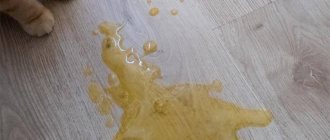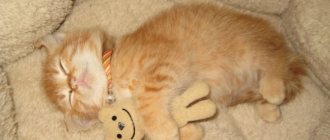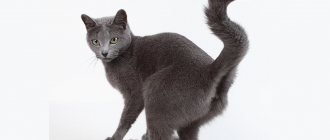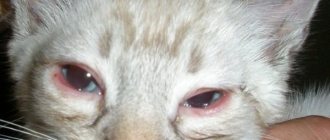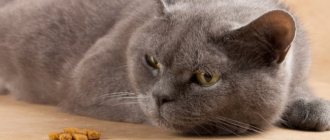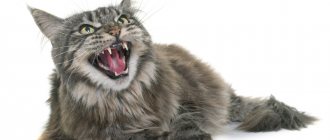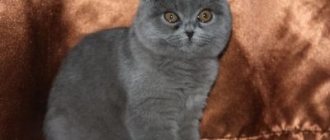Depending on the reason for your cat's weight loss, you may notice that her appetite has decreased or disappeared completely, a condition known as anorexia.
This is dangerous for cats because they are prone to something called hepatic lipidosis, or fatty liver syndrome, a life-threatening condition that can develop when the liver must process large amounts of stored fat to provide the body with energy.
But there are other medical situations that can cause your cat to lose weight even if she continues to eat normal amounts of food.
Regardless of whether your cat is eating or not, if you notice that she is losing weight, it is important to consult your veterinarian.
If you are unsure what your cat's ideal weight should be, your veterinarian will be able to provide guidance and suggest a feeding regimen that suits your cat's nutritional needs.
How does the condition manifest?
In cats, periods of increased activity are usually followed by apathy and drowsiness. It is difficult for owners to understand why and at what exact moments this happens. Therefore, a situation where a cat is lethargic, hardly eats and sleeps a lot, is alarming.
The owner should clearly know that poor appetite and less active behavior do not always indicate an illness in the animal. And the veterinarian is sometimes unable to understand why the cat is lethargic. The observations of an attentive and loving owner are extremely important here.
The main signs of cat health, in addition to good appetite and good spirits, are:
- shiny and smooth coat;
- pink and slightly moistened mucous membranes;
- cold and slightly damp nose (normally, during sleep it can become warm and dry);
- pulse, respiratory rate and temperature are within normal limits;
- absence of excessive discharge from the eyes, ears and nose, plaque in the mouth, salivation and unpleasant odor from the mouth and ears.
It is important! The normal duration of rest for a cat per day is 12-14 hours or more.
Diagnostics
The main difficulty in identifying the cause of weight loss is that it can be a sign of various disorders. Therefore, an in-person consultation with a veterinarian and a detailed examination is necessary.
In order to make an accurate diagnosis, tests are taken
It is imperative to undergo tests, since only they allow you to present a complete picture of the disease. In order to understand why a cat is losing weight, a general and biochemical blood test is prescribed, urine and feces are studied. Already these data will give an idea of the work of internal organs.
It is advisable to take an x-ray of the abdomen and chest. Treatment is prescribed only after the exact cause of weight loss has been established. If the animal has a small amount of fur accumulated, then a special paste is sufficient.
If an inflammatory process is detected in the mouth, it is recommended to clean the tartar and use healing ointments. This hygiene procedure should be done once a year.
The most difficult thing is to correct hormonal disorders. During heat, the animal behaves inappropriately and this cannot be changed in any way. Light sedatives will not completely eliminate sexual desire. Therefore, it is better to castrate and sterilize non-breeding animals.
Important! The operation is completely safe for pets and improves their quality of life.
The heat does not always occur in the spring. In some animals it occurs at any time of the year. Sterilization helps protect your cat from developing mammary cancer. Castration of males is not so traumatic and allows you to wean the cat from marking its territory.
A cat may be thin due to worms. In this case, a course of special medications is sufficient. They should only be prescribed by a doctor, since the type of parasites and the degree of infestation matter.
Serious diseases are the most difficult to treat. In oncology, much depends on the size of the tumor and its location. In some cases, surgery can extend the life of a pet.
The earlier the problem is identified, the greater the chances of its successful treatment.
Bacterial infections are treated with a course of antibiotics, viral diseases with supportive medications. If a cat has discharge from the eyes, the owner should clean them regularly.
In addition to treatment, it is important to create special conditions for the pet’s recovery. To do this, they will organize a quiet and peaceful place for him to relax. The cat is allowed to sleep as much as he wants. During the treatment period, he is provided with nutritious, high-quality nutrition.
Popular brands of food have special dietary lines that allow you to provide the animal with all the necessary vitamins and minerals.
Important! If a cat's teeth fall out, it is provided with soft food during this period. Pates or baby meat puree are suitable.
Signal of a foreign body entering the digestive tract
Most owners often encounter this problem, which is especially typical for playful cats of long-haired breeds. These could be small fragments of toys, small bones, or simply large accumulations of fur from the animal itself. The main signs for identifying this factor are attacks of vomiting that occur when drinking water and food, abdominal pain and difficulty defecating. With prompt diagnosis and timely removal of the foreign material, the pet will recover completely.
Signs of poor appetite
If an animal sometimes refuses to eat, then there is nothing wrong with that. You may not always notice weight loss right away. Cats that live indoors need less food. Therefore, they may sometimes not feel hungry and drink only water.
Loss of appetite may be a sign of serious problems
Veterinarians identify several thinness indices. When exhausted, the animal's ribs clearly appear; if you look at it from above, its figure will resemble an hourglass. The stomach is strongly retracted.
If the cat is underweight, the ribs and spine will be clearly palpable, and there will be no fat layer. With normal weight, the animal looks like an even rectangle from above. The ribs can be felt during normal examination, but a small amount of fat will be felt.
Important! Being overweight is just as dangerous as being underweight.
The owner should only start to worry if the cat is emaciated or underweight. In this case, it is better to consult a veterinarian to determine the cause of the weight loss.
Sometimes the condition is accompanied by additional symptoms - vomiting, drowsiness, lethargy. All this may indicate the development of a serious illness. A particularly dangerous sign is refusal of water.
Why does a cat eat little and sleep a lot for several days?
In most cases, the reason for a cat's lack of activity is due to trivial reasons.
Why does a cat eat little and sleep a lot for several days, reasons:
- The advanced age of the animal . If the cat is more than 10 years old, you shouldn’t be surprised if it turns from an active, cute kitten into a lethargic pet. Animals, like people, move less in adulthood and develop a large number of chronic ailments.
- Condition after estrus . If you have been breeding a cat, then do not be surprised if 3-4 days after this process it becomes lethargic. Over the course of 3-4 weeks, the animal will be quite lethargic and behave differently than usual. This indicates that the mating was successful, the animal needs rest, as well as good care, in order to raise strong and healthy offspring.
- Increase in ambient temperature . At a temperature of +30, not only people, but also animals do not feel very good and cheerful. The animals have decent fur, with the exception of sphinxes. Therefore, pets feel bad; often in hot weather, animals prefer to hide under the sofa, bed and in places where it is quite cool and sunlight does not penetrate. Pets hide, sleep a lot and are reluctant to come when called.
Kittens
What diseases have lethargy as a symptom?
Poisoning
Most often, veterinarians encounter lethargy in poisoned cats. An animal can become poisoned either while walking on the street or at home (for example, from chocolate).
If a cat is poisoned, it may also experience the following symptoms: vomiting, diarrhea, increased salivation, shortness of breath, unsteady gait, swollen tongue, restlessness, oral burns, tremors, convulsions or coughing.
If you think your cat's lethargy is due to poisoning, you should take her to the vet immediately.
Other
Lethargy is a symptom of most diseases, for example:
- renal failure; — feline immunodeficiency virus; — feline leukemia virus; — hypothyroidism (decreased activity of the thyroid gland); — Lyme disease; - dirofilariasis of the heart; - anemia; - diabetes; - liver diseases; - problems with blood pressure; — infectious peritonitis of cats; - bile spillage; - cancer; - purulent endometritis; - sometimes - a cold or allergy.
Since lethargy is not a disease, but only a symptom, the disease itself should be treated.
Articles on the same topic:
Why do cats sleep a lot? Can cats eat salty food? What should not be in cat food? Does a cat feel pain during childbirth? Does a cat grow a mustache?
If your cat begins to eat little due to kidney failure
There are two types of kidney failure in cats - acute and chronic, which are characterized by refusal to eat. There is severe emaciation of the animal, frequent vomiting and urination, as well as a constant feeling of thirst. A common cause of this condition may be poisoning from flowers of the lily family. The condition of acute renal failure can be treated with timely contact with an experienced veterinarian. Resuscitation facilities and prompt implementation of treatment procedures will help restore your pet’s health in the shortest possible time.
The cat is lethargic and sleeps all the time: what is the reason?
Among the pathological causes of lethargy are the following:
- poisoning,
- hormonal disorders after childbirth or as a result of using contraceptives,
- side effects of corticosteroid anti-inflammatory drugs,
- musculoskeletal pathologies,
- infectious diseases,
- worms;
- anemia;
- hypovitaminosis;
- tumors;
- chronic diseases.
Stress causes ambivalence in cats. The pet may become sleepy or, conversely, show aggression.
Reasons for refusal to eat due to cat illness
Oral diseases. Stomatitis is an inflammation of the oral mucosa involving the mucous membranes of the cheeks, palate, gums, surface of the tongue and the mucous membrane of the lips. In cats, catarrhal, vesicular and hemorrhagic most often occur, and much less often ulcerative, diphtheretic and phlegmonous.
Stomatitis in a cat usually begins with catarrhal inflammation of the oral mucosa and is accompanied by: Increased salivation. Increased thirst. Chew carefully while eating (cat stomatitis).
Dental caries is a disease accompanied by progressive putrefactive destruction of hard tissues followed by the formation of a cavity in the affected tooth. The onset of dental caries development is usually overlooked by cat owners. The owner of a cat can detect dental caries in his cat due to difficulty in eating and chewing food, as a result of the appearance of a pain reaction, the presence of salivation, the loss of swallowed food particles from the oral cavity and an unpleasant odor (bad breath in a cat) that comes from the cat’s oral cavity, purulent or bloody discharge from the mouth.
Tartar. An unpleasant odor emanates from the cat’s mouth, we note atypical behavior in the cat when eating (arising from pain), the cat begins to refuse food, and exhaustion is observed (tartar in the cat).
Wounds and abscesses in the cat's mouth are accompanied by pain, which makes it difficult for the cat to eat, and as a result the cat refuses to eat.
Ear disease. Ear diseases in cats can be non-contagious or contagious in origin.
Otitis. Otitis in cats can be due to inflammation of the outer, middle and inner ear.
Causes of otitis. The cause of otitis in cats can be food allergies, the presence of parasites (ticks, fleas), ear injuries, foreign bodies, etc. Otitis of the middle and inner ear can be the result of complications of inflammation of the outer ear.
Signs of otitis. During a clinical examination of a sick cat, the skin of the sore ear is reddened, the cat rubs the sore ear with its paw, and tries to keep the sore ear folded and pressed to its head. If the pain in the ear is acute, “shooting,” the cat suddenly jumps up, looks around in fear, and screams. With constant pain, the cat does not allow the sore ear to be touched, avoids stroking the head, and presses the sore ear to its bedding. With purulent otitis media, inflammatory exudate is released from the cat's ear; when touched, the ear gurgles and squelches. An unpleasant odor emanates from the diseased ear. In advanced cases, in the absence of proper treatment, the cat’s body temperature rises, the cat becomes depressed, and there is no appetite. If timely treatment measures are not taken, the eardrum may be perforated, and the inflammatory process can spread to the brain (ear diseases in cats).
Cat worm disease
Worms or helminthic diseases are most common among cats. Owners of their pets should clearly understand that helminthic diseases can occur even if your pets have not left your apartment. They can become infected with existing parasitic worms through eggs of various helminth infections brought from the street on the soles of their shoes. Cats during walks, in close contact with the environment, expose themselves to the danger of becoming infected with helminth eggs, which are found in large numbers on various objects. A particularly great danger in this regard is provided by the direct contact of your cat with other homeless, stray animals. Being essentially predators, cats never refuse raw fish or meat offered to them, which in our time of market relations can be infected with helminthic infestation. Some types of worms cause characteristic, pronounced symptoms of helminthic disease. With severe infestation, the cat loses a lot of weight, even with a good appetite. A sick cat vomits (vomiting in cats), sometimes with blood, and gastrointestinal tract disorder (diarrhea) appears (diarrhea in cats). Kittens infected in utero may die from blockage or rupture of the small intestine. In young cats we note anemia and gastrointestinal disorders. Other worms, hiding in the muscles or liver of a cat for a long period of time, do not show themselves in any way. Taking into account the above, cat owners need to carry out preventive deworming with anthelmintic drugs. For more information about worms, see our article - worms in cats.
Cat affected by ectoparasites. Very often, our cats suffer from diseases that are caused by various parasites that live both outside and inside the animal’s body. Ectoparasites—fleas, lice, and ticks—settle on the skin of cats.
Fleas are wingless insects with a body flattened on the sides. Only adult individuals parasitize the body of cats; the larvae live in the environment. Fleas are extremely prolific - each female lays 25 eggs daily, which fall down, accumulating on the litter, in the cracks of wooden floors, on carpets, etc. After hatching from the eggs, the larvae, after going through a series of changes, turn into adults, which, when they meet a cat, settle in her fur and switch to a parasitic lifestyle. They bite him and drink his blood; as a result of severe flea infestation, the cat loses weight. The presence of fleas in an animal can be indicated by the presence of small black crumbs on the cat’s body.
Oncological diseases. Like other types of domestic animals, cats are prone to cancer. Moreover, the majority of neoplasms identified in cats are malignant in nature, so this pathology requires complex treatment in a modern veterinary clinic by an experienced veterinary specialist.
A malignant tumor in a cat occurs as a result of a malfunction of DNA molecules, which are a repository of information and are present in every cell of the cat.
A malignant tumor, as it grows, increases in size and begins to grow into the healthy tissue of the affected organs, causing inhibition of their function.
The clinical picture of cancer in a cat depends on the organ affected by cancer, the stage of the disease and the general condition of the cat. For many years, the neoplasm in a cat cannot be externally manifested in any way. Symptoms of the disease in an animal may be vague and unclear.
In cases of liver cancer, veterinary specialists note general weakness, fatigue, decreased appetite in a cat, a change in the consistency and color of feces, and a sharp decrease in weight. The cat begins to develop jaundice (visible mucous membranes, the cornea of the eyes and the skin acquire a yellowish tint). Disease symptoms characteristic of liver disease in cats appear.
Stomach cancer in cats. During a clinical examination, the veterinarian notes that the cat has general weakness, drowsiness, poor appetite, and a painful abdomen on palpation. Increased body temperature. There is a change in the color and consistency of fecal matter, sometimes we find blood clots in the fecal matter, the cat suddenly loses weight, and anemia develops.
Bowel cancer. During a clinical examination, a veterinarian finds the same clinical signs in a sick cat as for stomach cancer. Unlike stomach cancer, fresh, scarlet blood appears in the stool, a foul odor emanates from the feces, and bloating occurs. A fetid odor is felt from the oral cavity, and rumbling sounds are heard on auscultation of the intestines. Depending on the affected part of the intestine, there may be diarrhea (diarrhea in a cat) or, on the contrary, constipation (constipation in a cat (coprostasis).
For more information about oncological diseases in cats, see our article - oncology in cats.
Infectious diseases
Infectious diseases in cats are caused by a variety of bacteria and viruses, in which the animal’s body experiences loss of body weight (weight loss) due to loss of appetite and disorders of the gastrointestinal tract. The most common infectious diseases of cats include - (infectious rhinotracheitis in cats, chlamydia in cats, mycoplasmosis in cats, bordetellosis in cats, calcivirus infection in cats, panleukopenia in cats, infectious peritonitis in cats).
Internal non-communicable diseases
Almost all diseases accompanied by loss of appetite and even the entry of a foreign object into the stomach can lead to weight loss.
Common internal non-contagious diseases in cats include:
Kidney stones in cats or urolithiasis is a chronic disease of cats in which stones and urinary sand (urolithiasis) form in the urinary tract of animals. Urolithiasis (UCD) is a chronic disease associated with metabolic disorders and accompanied in a cat by the formation and deposition of urinary stones, different in chemical composition, or sand in the renal pelvis, urinary ducts, bladder, urethra and leading to disruption of natural outflow urine.
Symptoms of the disease. If a cat’s kidney stones are small and there is no blockage in the urinary tract, then the cat’s disease occurs without obvious clinical signs, but the results of laboratory tests of urine and blood indicate its occurrence. During such a latent period of the course of urolithiasis, symptoms can be detected in a cat that not only indicate its development, but also allow a veterinarian to determine the location of the urolithiasis. The cat's owners notice a decrease in appetite, drowsiness, and depression. When a stone forms in the renal pelvis, a cat develops symptoms characteristic of pyelitis. Owners sometimes find blood in their cat's urine (hematuria), especially after active movements of the cat. The presence of stones in the cat's bladder is manifested by frequent urge to urinate and restlessness. In the case when a kidney stone begins to move along the ureter and causes its blockage, we observe ureteral obstruction. With partial obstruction of the ureters, owners note difficulty urinating in the cat. Urination becomes strained, and the cat sometimes cries while peeing. The cat's urination becomes frequent with the release of a small amount of urine; upon careful examination, blood can be detected in the urine. Additionally, the owners note a lack of appetite in the cat, vomiting, and the abdominal area becomes painful upon palpation.
For treatment and prevention of this widespread disease in cats, see our article - Kidney stones in cats or urolithiasis.
Liver diseases – Hepatitis is the general name for inflammatory diseases of the liver tissue. Hepatitis often occurs simultaneously with diseases of the stomach, intestines, pancreas and other organs. With hepatitis, the gallbladder and bile ducts are almost always involved in the process. Hepatitis is accompanied by profound disturbances in protein, carbohydrate-fat and pigment metabolism, and liver cells disintegrate.
Cirrhosis of the liver - in a cat, it is accompanied by a change in the liver’s structure due to the growth of connective tissue in the liver.
Liver failure is a severe pathological condition of an animal in which liver function is impaired. Liver failure in cats can occur in acute and chronic forms.
Main symptoms of liver disease in cats.
Liver disease in cats is characterized by a number of signs that should alert its owner. An owner can suspect liver disease in their cat based on the following symptoms:
Vomiting in a cat. Cat has diarrhea. Jaundice, in which icteric staining of the mucous membranes and subcutaneous tissue occurs in a yellow color. Skin itching. Change in urine color, from yellow to brown. Change in color of feces from brown to gray or brown. Abdominal dropsy, ascites - an increase in the volume of the abdomen due to the accumulation of fluid in the abdominal cavity. An increase in the size of the liver, which manifests itself as a protrusion through the abdominal wall. Pain in the liver area (hepatic colic). Multiple hemorrhages in the skin and subcutaneous tissue. Poor blood clotting.
A number of endocrine diseases - problems with the thyroid gland, diabetes (even cats are susceptible to this insidious disease) are certainly accompanied by weight loss even with an increased, and sometimes perverted, appetite.
Diseases of the digestive system lead to a cat’s weight loss, even while maintaining the same amount of food eaten.
How and how to help an animal
If a cat refuses food and water, then the first thing to do is take your pet to a veterinarian. It is not possible to make a diagnosis on your own at home, so you need to call a doctor at home or take your pet to the clinic.
If it is impossible to get to the veterinarian in the next 24 hours, then you need to provide the cat with rest. To do this, you should prepare a clean litter; it should not be too soft or too hard. If an animal is hiding, you should not force it out of its hiding place. You can only place a bowl of food and fresh water nearby.
Bowls of water and food should always be available to the animal.
If the doctor has determined the cause, then you should follow the specialist’s recommendations and give medications according to instructions in the required dosages. This must be done calmly; you must not cause pain to the animal. Before giving medication, the cat needs to be stroked, and the tone of voice should be calm. This way, the pet will tolerate the treatment better, will not resist too much and will recover faster.
Additional recommendations:
- If the cause is stress, then the cat should be left alone for a while. It is advisable to call her to eat in a gentle tone. A calm and quiet environment, the absence of extraneous noise and periodic stroking will help you recover from stress.
- If your pet doesn't like the food, you need to replace it as soon as possible. It is recommended to give preference to balanced foods rather than cheap options containing a lot of harmful additives.
- In case of gastrointestinal upset and poisoning, you can give the animal activated charcoal (500 mg per 1 kg of weight). In this case, the tablet must be crushed and dissolved in 1 tsp. water. It is most convenient to give medicine using a syringe without a needle. It is enough to do this procedure once before seeing a doctor.
- Ticks and fleas are eliminated using special antiparasitic medications. You should not use them on your own; you should first consult your doctor. However, if this is not possible in the near future, and the animal has fleas or a tick is found, you can purchase Bars or Celandine shampoo.
- If the cause is helminthic infestations, then treatment is carried out with the help of anthelmintic drugs. The medication should be given only according to the regimen recommended by the doctor. Otherwise, larvae may remain, which will provoke a relapse.
- To alleviate the condition of an animal with gum inflammation, you can use a solution of Miramistin or potassium permanganate. It is necessary to treat the gums using a cotton pad and the selected product. This needs to be done 2 times a day. Do not press on problem areas.
A weak solution of potassium permanganate can be used to treat inflamed gums
If an animal does not eat or drink, and also sleeps constantly, then this is an alarming signal of serious health problems. However, in extremely rare cases this is associated with stress. In this case, the pet should be left alone and allowed to rest. There is no danger in inactivity after stress. If the animal is lethargic, does not eat or drink for another reason, then postponing a visit to the doctor is dangerous, since with a serious pathology the cat may die.
Some recommendations that will help you hold out until the doctor arrives:
- It is necessary to ensure that fresh air enters the room.
- Do not disturb the pet. If there are other animals in the house, then for safety reasons it is better to isolate them from contact with the sick cat.
- Make sure the water in the bowl is always clean.
- If there is a special medicinal herb for cats in the house, which breeders often grow in pots, then you can pick a little and put it next to your pet. If desired, the animal can be treated with such a safe remedy.
How to help a kitten
If the kitten does not eat anything or drink water, then first of all you need to pay attention to the nature of the food. Small pets need special soft food. It is impossible to give a kitten food intended for adult animals, since the gastrointestinal tract of babies is still very weak. Long-term refusal of water is dangerous, so you can give your pet water using a pipette. Every hour you need to give water forcibly. The liquid should be administered in small quantities - one pipette at a time is enough.
Giving your kitten water using a pipette will prevent dehydration
In addition, the kitten should be carefully examined for rashes, sores and fleas. Particular attention should be paid to the withers and ears. If everything is clean, then most likely the problem lies in the functioning of the internal organs, which can only be determined in a clinical setting.
When to rush to the vet
Within 24 hours after discovering that the cat is not eating or drinking, you should simply observe it, paying attention to other symptoms, if any. But even if in general the pet’s condition does not cause concern (refusal of food and drowsiness are the only signs), it is still worth consulting with a veterinarian, because many pathologies have a hidden course (for example, the presence of malignant tumors becomes obvious only in the later stages).
If you have the following symptoms, you should contact your veterinarian as soon as possible:
- vomiting and diarrhea - usually always accompany poisoning or infectious diseases, and also increase the risk of rapid dehydration;
- increased temperature - it should be remembered that a temperature of up to 39 degrees is normal for cats, and only exceeding this indicator indicates a fever;
- rashes of any type - we can talk about both an allergic reaction and an infection;
- hair loss - may be a symptom of an infectious lesion or parasitic infestation.
You should be especially wary if the pet hides in secluded corners and avoids contact with the owner - only very sick animals behave this way.
What should an owner do if a cat doesn’t eat well?
First of all, you need to decide whether the owner is able to help the pet on his own. If yes, then you need to do as described above.
If a combination of the following symptoms occurs, seek veterinary help:
- the pet does not drink or eat;
- the cat is reluctant to chew food and has difficulty swallowing;
- halitosis - bad odor from the mouth;
- the cat constantly licks itself;
- diarrhea or stool retention develops;
- salivation;
- vomit;
- the coat is tousled and dull;
- skin rashes;
- conjunctivitis, rhinitis and dry nose at the same time.
What is lethargy or lethargy?
Lethargy is the absence or lack of energy or enthusiasm. Lethargic cats appear depressed, tired or lethargic, sleep more than usual, and do not play as much as usual. They may also appear weak and less active than usual. Lethargic cats may be reluctant to get up to use the litter box and may become ill in other ways.
Some lethargic cats also have a fever, an upset stomach with vomiting or diarrhea, or are uninterested in food, water, or favorite treats. If lethargy continues for a period of time, they may show signs of weight loss or muscle atrophy.
© shutterstock
Other pathologies
In addition to the listed pathological conditions of cats, accompanied by lethargy, drowsiness and loss of appetite, the following painful conditions also occur:
- disturbances in the functioning of the endocrine system.
For example, after sterilization or childbirth due to hormonal imbalance, cats become lethargic and inactive.
Pets suffering from diabetes also do not want to move too much. In addition, such cats are constantly thirsty, eat a lot or very little, and often go to the toilet. They experience weight fluctuations, their vision deteriorates, their stomach enlarges, their muscles weaken;
- oncological diseases.
One of their symptoms in cats is a lethargic state. Changes in the pet’s well-being are clearly visible: the cat hardly eats, lies down all the time, vomits, and experiences internal bleeding. Such animals have very unpleasant breath, and upon visual examination, swelling and ulcers can be detected on the body;
- diseases of the musculoskeletal system.
Even an inexperienced owner can easily recognize them. With arthritis, dislocations, sprains, osteochondrosis, fractures and other problems, animals become lethargic, try to eat and move less. Cats' affected joints swell, they limp, rarely sharpen their claws and wash themselves. All movements cause them pain;
- complications after surgery.
Usually, in the first three days after the intervention, cats are very lethargic. This condition, in the presence of appetite and thirst, is considered normal.
But, if the animal’s temperature rises, blood or pus begins to ooze from the wound, vomiting or constipation often occurs - you need to contact the clinic as soon as possible. After all, these can be dangerous symptoms of suture dehiscence or suppuration, or the formation of a hernia.
Emergency assistance before the veterinarian arrives
At the first signs of refusal to eat, the main thing is not to panic and try to soberly approach the issue of determining the reasons:
- Eliminate the possibility of purchasing unsuitable food
- Try replacing food
- Call emergency veterinary help
- Do not start self-medication
- Test your cat's sense of smell while giving her warm food from your hand.
- Watch the cat, especially if you are in a suburban area - maybe the cat ate a mouse or ate from the neighbors
- Avoid pet overeating
Every owner of a cat must remember that neglect of a pet can affect the occurrence of poor appetite and the development of dangerous diseases. Contacting a veterinary clinic when the first symptoms of food refusal appear will help the veterinarian quickly make a final diagnosis and prescribe the most effective treatment. The health of your pets is in your hands, and attention and care will help prevent the appearance of the above-described signs associated with loss of appetite.
When a cat's condition should cause alarm
The owner of the animal should be wary of prolonged fasting. For kittens the critical period is one day, for older pets - 2; cats for three days. An alarming sign is refusal to drink, a drop in temperature below normal, and excessive salivation.
Be sure to read:
What to do, the cat is sneezing, the eyes are watery or festering, reasons
In such situations, emergency veterinary care is required.


